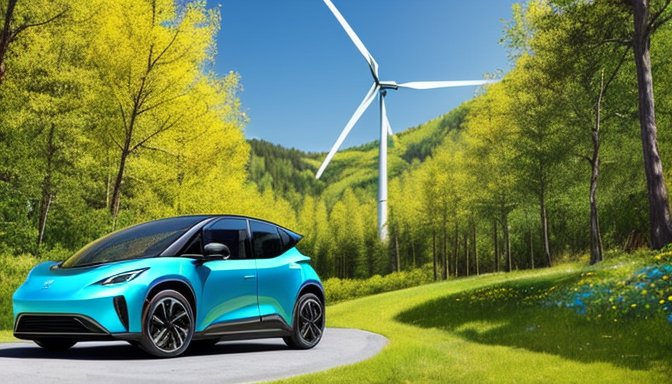Are you ready to dive into the electrifying world of electric vehicles (EVs)? The automotive landscape is undergoing a remarkable transformation, and it’s not just a passing trend; it’s a revolution! With each passing year, we see more innovative designs and technologies reshaping how we think about driving. Imagine a future where your car is not just a mode of transport, but a smart companion that enhances your daily life. From sleek designs to advanced features, EVs are paving the way for a new era in transportation.
But what does the future hold for these green machines? As we look ahead, we can expect a surge in hybrid and fully electric models, each boasting improved ranges that can take you further than ever before. Have you ever thought about how charging stations are popping up like coffee shops? That’s right! The infrastructure for EVs is expanding rapidly, making it easier for you to charge up while you’re on the go. Plus, with advancements in battery technology, we’re seeing longer-lasting power sources that could change the game entirely.
So, what’s next? The integration of autonomous driving capabilities is on the horizon, allowing cars to navigate traffic while you sit back and relax. Imagine a world where you can catch up on your favorite show during your commute! The possibilities are endless, and the excitement is palpable. Buckle up, because the ride into the future of transportation is just getting started!
Technological Advancements in EVs
As we dive into the future of transportation, electric vehicles (EVs) are leading the charge, quite literally! The evolution of EV technology has been nothing short of revolutionary, transforming how we think about driving. Imagine a world where your car is not just a mode of transport but a smart companion. Battery technology is at the heart of this transformation. Recent advancements in lithium-ion batteries have significantly increased their efficiency, allowing for longer ranges and shorter charging times. For instance, some of the latest models can now travel over 300 miles on a single charge, making range anxiety a thing of the past.
Moreover, the development of fast-charging infrastructure is making it easier than ever to keep your EV powered up. With charging stations popping up in urban areas, highways, and even at workplaces, drivers can quickly recharge while they grab a coffee or run errands. This convenience is crucial for mainstream adoption. But that’s not all! The integration of autonomous driving capabilities is taking EVs to the next level. Imagine relaxing in your car while it navigates through traffic, thanks to advanced sensors and AI technology. This not only enhances the driving experience but also promises to reduce accidents caused by human error.
To sum it up, the future of EVs is bright, fueled by continuous innovation. As technology progresses, we can expect even more exciting developments that will reshape our roads and our lives. So, buckle up and get ready for a thrilling ride into a greener, smarter future!

Environmental Impact and Sustainability
The shift towards electric vehicles (EVs) is not just a trend; it’s a revolution in the automotive industry that has profound implications for our planet. As we dive into the future of transportation, it’s vital to understand how these vehicles contribute to a more sustainable world. Imagine a city where the air is cleaner, the streets are quieter, and the reliance on fossil fuels is drastically reduced. This is not a distant dream but a reality that electric vehicles are helping to create.
One of the most significant advantages of EVs is their ability to reduce carbon emissions. Traditional gasoline-powered cars release a considerable amount of greenhouse gases, which contribute to climate change. In contrast, electric vehicles produce zero tailpipe emissions. However, it’s essential to consider the entire lifecycle of an EV, including the source of electricity used to charge them. When powered by renewable energy, the environmental benefits multiply exponentially.
Moreover, the manufacturing of EVs is evolving. Companies are increasingly adopting sustainable practices, such as using recycled materials and improving battery technology to minimize waste. For instance, advancements in battery recycling are paving the way for a circular economy in the automotive sector. This not only reduces the demand for raw materials but also lessens the environmental footprint of production.
In summary, the rise of electric vehicles represents a critical step towards a greener future. As we embrace this technology, we must also remain vigilant about sustainability practices in manufacturing and energy sourcing. The question remains: are we ready to fully commit to this change for the sake of our planet?
Frequently Asked Questions
- What are electric vehicles (EVs)?
Electric vehicles (EVs) are cars powered entirely or partially by electricity. Unlike traditional vehicles that run on gasoline or diesel, EVs use electric motors and batteries, making them more environmentally friendly and efficient.
- How do EVs contribute to sustainability?
EVs help reduce carbon emissions, which is crucial in combating climate change. By using renewable energy sources to charge, they can significantly lower the overall carbon footprint associated with transportation.
- What advancements are being made in EV technology?
There are exciting innovations in battery technology, such as longer ranges and faster charging times. Additionally, improvements in charging infrastructure and the development of autonomous driving features are enhancing the overall EV experience.
- Are EVs really cost-effective?
While the initial purchase price can be higher, EVs often have lower operating costs due to reduced fuel and maintenance expenses. Plus, many governments offer incentives that can help offset the upfront cost!
- What is the future of electric vehicles?
The future looks bright! As technology advances and infrastructure improves, we can expect more affordable options, greater adoption rates, and a significant shift towards sustainable transportation solutions.